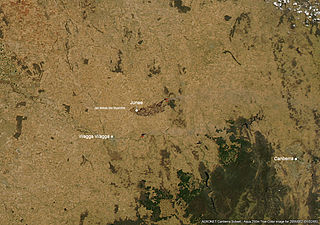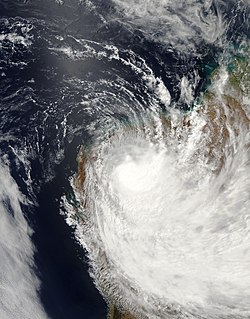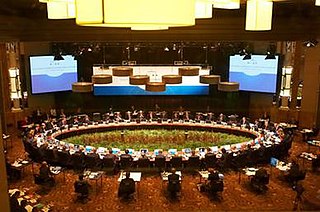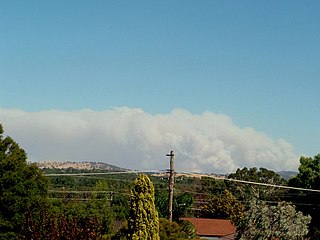 W
WThe 2006 Junee bushfire, officially referred to as the "Jail Break Inn fire", was a bushfire that burned from 1–6 January and primarily affected the Riverina region in the Australian state of New South Wales. At least 25,200 hectares of farmland and forest reserve in the municipality of Junee Shire were burned during the 6-day duration of the fire. Ten houses, four shearing sheds and numerous other vehicles and non-residential buildings were destroyed, and damage was also caused to the Junee Round House. Rural industry in the Junee area was also significantly affected by the fire; over 20,000 head of livestock perished or were put down due to fire related injuries, 20 hectares of unharvested crops were burned and 1,500 kilometres (930 mi) of fencing was damaged. The fire affected 200 properties in and around the communities of Bethungra, Eurongilly, Illabo, Junee and Old Junee.
 W
WThe Beaconsfield gold mine collapsed on 25 April 2006 in Beaconsfield, Tasmania, Australia. Of the seventeen people who were in the mine at the time, fourteen escaped immediately following the collapse, one was killed and the remaining two were found alive on the sixth day by miners Pat Ball and Steve Saltmarsh. These two miners were rescued on 9 May 2006, two weeks after being trapped nearly a kilometre below the surface.
 W
WOne of the most extensive bushfire seasons in Australia's history. Victoria experienced the longest continuously burning bushfire complex in Australia's history, with fires in the Victorian Alps and Gippsland burning over 1 million hectares of land over the course of 69 days. See Bushfires in Australia for an explanation of regional seasons.
 W
WCarpentaria is the second novel by the indigenous Australian author Alexis Wright. It met with widespread critical acclaim when it was published in mid-2006, and went on to win Australia's premier literary prize, the Miles Franklin Award, in mid-2007.
 W
WSevere Tropical Cyclone Clare was a moderately strong cyclone that struck Western Australia in January 2006. The storm formed as an area of low pressure in the Arafura Sea, and moved westward. After receiving the name Clare on 7 January, the system ultimately peaked at Category 3 intensity on the Australian tropical cyclone scale. It moved ashore on the coast of Pilbara and proceeded inland, dissipating on 10 January. Clare produced winds of 142 km/h (88 mph) at Karratha and triggered widespread torrential rainfall that led to flooding. Following its usage, the name Clare was retired by the Bureau of Meteorology, and will never be used again for a tropical cyclone in the area.
 W
WStephen Robert Irwin, nicknamed "The Crocodile Hunter", was an Australian zookeeper, television personality, wildlife expert, environmentalist, and conservationist.
 W
WTropical Cyclone Emma was a weak but unusually large tropical cyclone that affected a substantial portion of Western Australia during the 2005–06 Australian region cyclone season. Forming out of an area of low pressure on 25 February, the precursor to Emma slowly tracked southward. Although classified tropical, the structure of the system represented that of a monsoonal storm. However, low wind shear and well-developed outflow gradually allowed convection to develop near the centre of circulation. As the system approached the Pilbara coastline of Western Australia on 27 February, it intensified into a Category 1 cyclone and attained peak 10-minute sustained winds of 75 km/h (45 mph). After moving inland near Mardie, Emma weakened to a tropical low but became exceedingly large; its cloud cover obscured most of Western Australia. The remnants of the weak storm persisted until 1 March, at which time they dissipated over the Great Australian Bight.
 W
WThe 2006 Australian federal budget for the Australian financial year ended 30 June 2007 was presented on 16 May 2006 by Peter Costello, the Treasurer of Australia in the Howard Government.
 W
WThe 2006 G-20 Meeting of Finance Ministers and Central Bank Governors was held in Melbourne between 18 and 19 November 2006. Issues discussed included "the outlook for the global economy; developments in resource markets and ways to improve their efficiency; the impact of demographic change on global financial markets; and further reform of the International Monetary Fund and the World Bank."
 W
WSevere Tropical Cyclone Glenda of March 2006 was among the strongest tropical cyclones to threaten Western Australia, though it weakened considerably before landfall and moved ashore in a lightly populated region. It began as a tropical low on 15 March in the Gulf of Carpentaria. The precursor disturbance drifted over Top End and later across the northeastern portion of Western Australia, and after emerging into the Indian Ocean it strengthened into a tropical storm. Aided by favourable environmental conditions, Glenda rapidly intensified to reach Category 5 status on the Australian cyclone scale, and with a peak intensity of 910 mbar it was among the strongest cyclones on record within the Australia region. On 30 March it moved ashore near Onslow as a Category 3 cyclone, and the next day it degenerated into a remnant tropical low over land.
 W
WTropical Cyclone Kate was a short-lived Category 2 cyclone that remained nearly stationary for its entire existence in the northwestern Coral Sea in February 2006. Forming out of a monsoonal trough on 22 February, Kate rapidly intensified throughout the day. By 23 February, the system attained its peak intensity with winds of 95 km/h and a barometric pressure of 985 hPa (mbar). Shortly thereafter, increasing wind shear caused the storm to quickly weaken. By 24 February, the system dissipated over open waters near Queensland, Australia. Although Kate did not directly affect land, large swells produced by the storm impacted beaches in Papua New Guinea and Queensland. The waves injured six people in Australia, although no property damage was reported.
 W
WSevere Tropical Cyclone Larry was a tropical cyclone that made landfall in Australia during the 2005–06 Southern Hemisphere tropical cyclone season. Larry originated as a low pressure system over the eastern Coral Sea on 16 March 2006, and was monitored by the Australian Bureau of Meteorology in Brisbane, Australia. The low-pressure area organized into a tropical cyclone two days later and quickly strengthened into a Category 4 storm on the Australian tropical cyclone scale. Larry made landfall in Far North Queensland close to Innisfail, on 20 March 2006, as a Category 5 tropical cyclone on the Australian scale, with wind gusts reaching 240 kilometres per hour (150 mph), before dissipating over land several days later.
 W
WSevere Tropical Cyclone Monica was the most intense tropical cyclone, in terms of maximum sustained winds, on record to impact Australia, tied with Cyclone Marcus in 2018. The 17th and final storm of the 2005–06 Australian region cyclone season, Monica originated from an area of low pressure off the coast of Papua New Guinea on 16 April 2006. The storm quickly developed into a Category 1 cyclone the next day, at which time it was given the name Monica. Travelling towards the west, the storm intensified into a severe tropical cyclone before making landfall in Far North Queensland, near Lockhart River, on 19 April 2006. After moving over land, convection associated with the storm quickly became disorganised.
 W
WThe Muslim Community Reference Group (MCRG) was an advisory body to the Australian federal government, set up by the Howard Government, from mid-2005 to mid-2006. The board served to provide the federal government with proposals on strategies and practices to help integrate the Muslim community and to foster greater understanding towards Muslims among the general society, public institutions and governmental bodies.
 W
WThe State Plan, A New Direction for NSW is a document prepared by the New South Wales Premier's Department within the Government of New South Wales and released on 14 November 2006. The plan, modelled on South Australia’s Strategic Plan, sets priorities for the state government over a ten-year period.
 W
WThe Pulletop bushfire, officially referred to as the Wandoo fire, started on the 6 February 2006 in hot dry and windy weather conditions approximately 30 kilometres (19 mi) southeast of Wagga Wagga in the Australian state of New South Wales. The fire was thought to have been started by sparks from a tractor on a property at Pulletop which quickly got out of control. The New South Wales Rural Fire Service declared a bushfire emergency and the Hume Highway was closed late in the afternoon with fears that the fire would threaten the towns of Humula, Book Book, Livingstone and Kyeamba after 10 square kilometres (3.9 sq mi) of farmland was burnt. By 7 February 2006 milder conditions helped firefighters to control the fire burning in inaccessible country.
 W
WSo where the bloody hell are you? was a A$180 million advertising campaign launched by Tourism Australia in 2006. It was created by the Sydney office of the London advertising agency M&C Saatchi.